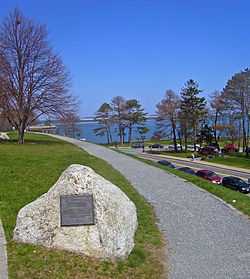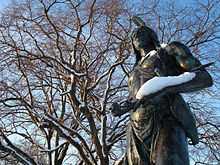Cole's Hill
|
Cole's Hill | |
 | |
|
NHL plaque on Cole's Hill with Plymouth Bay in background, 2008 | |
 | |
| Location | Carver Street, Plymouth, Massachusetts |
|---|---|
| Coordinates | 41°57′27″N 70°39′46″W / 41.95750°N 70.66278°WCoordinates: 41°57′27″N 70°39′46″W / 41.95750°N 70.66278°W |
| Built | 1620 |
| Governing body | Private |
| NRHP Reference # | 66000142 |
| Significant dates | |
| Added to NRHP | October 15, 1966[1] |
| Designated NHL | October 9, 1960[2] |
Cole's Hill is a National Historic Landmark containing the first cemetery used by the Pilgrims in Plymouth, Massachusetts in 1620. The hill is located on Carver Street near the foot of Leyden Street and across the street from Plymouth Rock. Owned since 1820 by the preservationist Pilgrim Society, it is now a public park.
Description
Cole's Hill rises steeply from the shore of Plymouth Bay, near Plymouth Rock, the traditional landing site of the Pilgrims in 1620. It is now bounded by Water, North, Carver, and Leyden Streets. The hill is landscaped with grassy areas, low shrubs, and some trees, and trails wind their way around the hill. A granite staircase rises from Water Street to the summit of the hill. A number of monuments and memorials are placed on the hill, most of which date to the period of the 1920 tercentenary (300-year anniversary) celebration of the Pilgrim landing. These include a Cyrus Dallin statue of the Wampanoag sachem Massasoit, whose support was critical to the Pilgrims' survival. At the southern end of the hill stands a granite sarcophagus containing remains disinterred from the hill in the 18th and 19th century, which are believed to be those of Pilgrim settlers buried here in 1620-21. Two stone benches, one placed by the Pennsylvania Society of New England Women, the other by Society of the Daughters of Colonial Wars, face seaward.[3]
History
The Pilgrims built their first houses on Leyden Street rising from the side of Cole's Hill to Burial Hill, and the hill was used in 1620-1621 as a burial ground during their first winter in New England. It was not known to be used as a burying ground afterward; the main cemetery was established in what is now called Burial Hill. This hill was later deeded to Samuel Fuller, a church deacon and the colony's physician. It afterward became the property of James Cole, who kept a tavern on the hill in the 1640s. The hill was acquired by the recently founded Pilgrim Society in 1820. The hill was transformed into a public park as part of the preparations for the tercentenary celebration. Existing buildings were removed from the hill and paths and plantings were added.[3]
Cole's Hill was declared a National Historic Landmark in 1960, and was listed on the National Register of Historic Places in 1966.[2][3]
See also
- Myles Standish Burial Ground
- List of National Historic Landmarks in Massachusetts
- National Register of Historic Places listings in Plymouth County, Massachusetts
References
- ↑ "National Register Information System". National Register of Historic Places. National Park Service. 2008-04-15.
- ↑ 2.0 2.1 "Cole's Hill". National Historic Landmark summary listing. National Park Service. Retrieved 2008-08-10.
- ↑ 3.0 3.1 3.2 Polly M. Rettig and Charles E. Shedd (December 10, 1974) National Register of Historic Places Inventory-Nomination: Cole's Hill, National Park Service and Accompanying three photos, from 1974
Images
-

Cole's Hill from near Plymouth Rock
-

Map of early Plymouth home lots
-

Cole's Hill marker, in memory of James Cole (1600-1692), first settler of Cole's Hill
-

Stereoscopic view of Cole's Hill in late 1800s with the Plymouth Rock canopy to the left
-

Massasoit statue at the top of Cole's Hill
| |||||||||||||||||||||||||||||||||||||||||||||||||||||||
